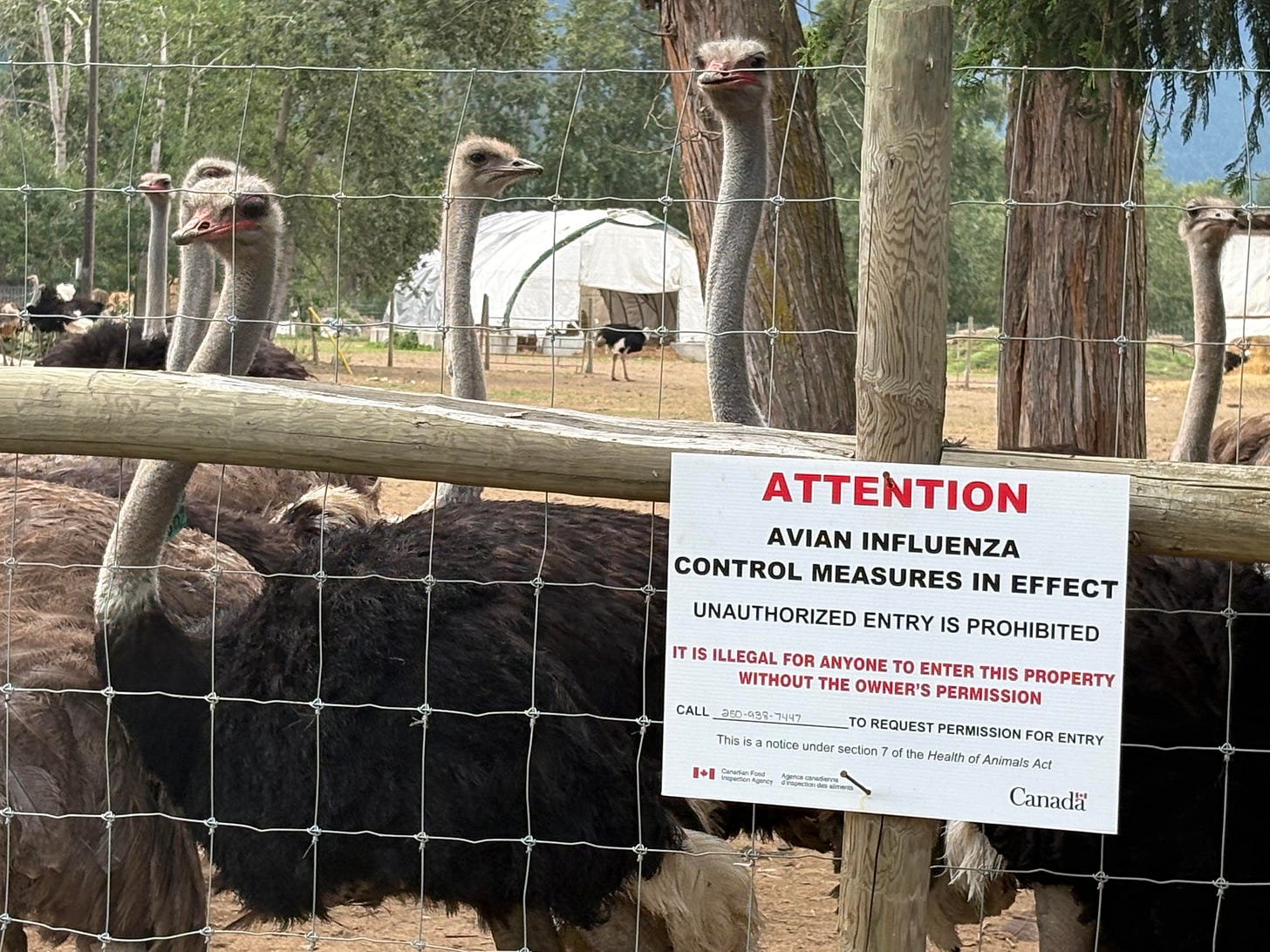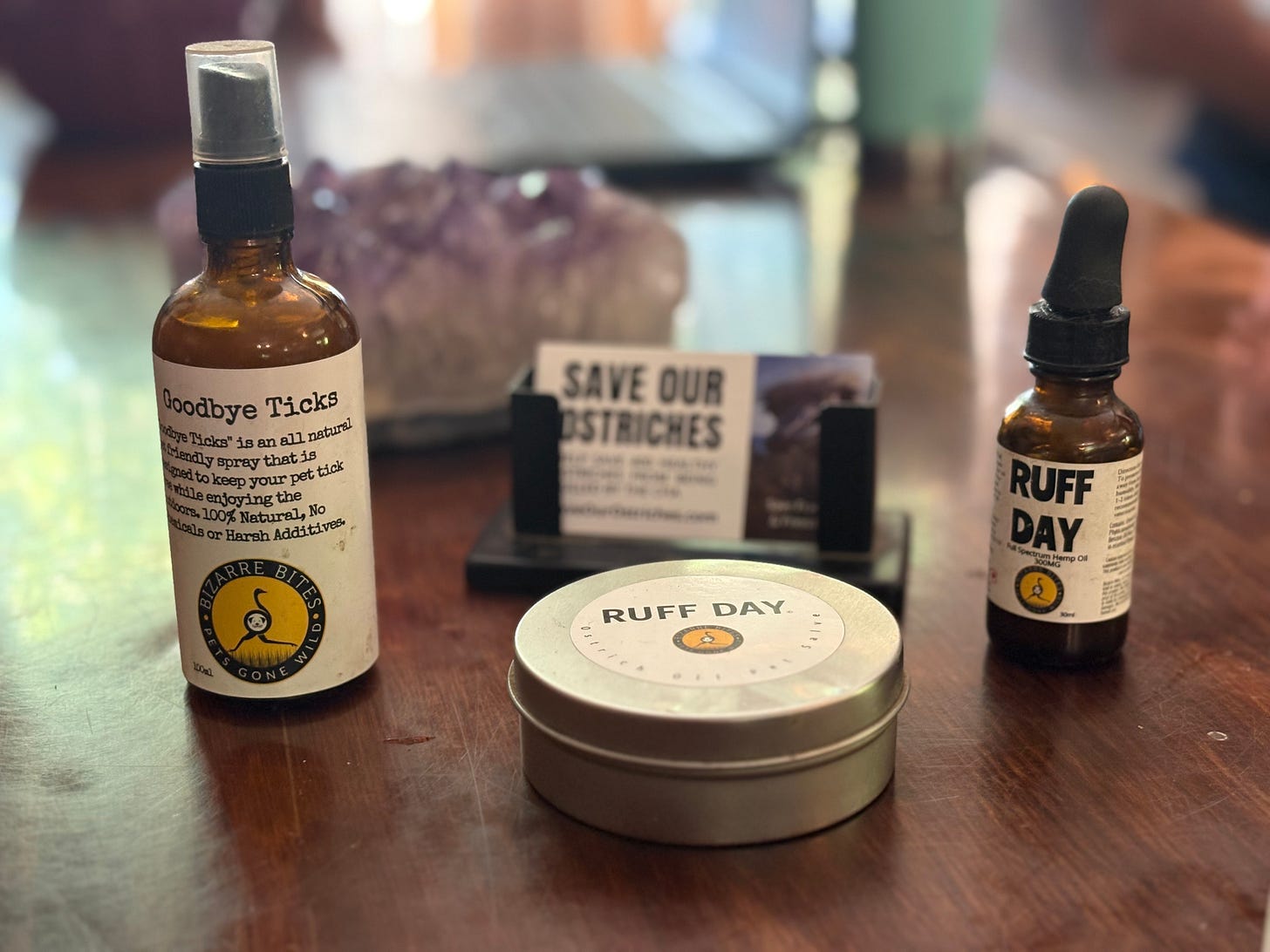Truth, Transparency, and the Farm They Tried to Erase
#SaveOurOstriches | #DueProcessMatters
By Maggie Hope Braun | Gather2030 | June, 15 2025
I’ve just spent a week on the ground at Universal Ostrich Farms in British Columbia — walking the land, observing the daily operations, and sitting at the kitchen table with the farmers and their families.
Every day, I asked the hard questions. I’ve seen the records. I’ve seen the birds. I’ve looked them in the eye, and I’ve looked the farmers in the eye too.
And here’s what I can say without hesitation…
In December 2024 to mid-January 2025, 69 ostriches died at the farm. Based on symptoms and history, the likely cause was Pseudomonas aeruginosa, a bacterial infection the farmers had encountered before and knew how to treat. Some birds were lost, but the rest recovered and are thriving.
Despite this, the CFIA swabbed two dead birds, ran PCR tests for H5 (not H5N1), and immediately declared H5N1 — which lead to the order to destroy one of the healthiest, most genetically diverse ostrich flocks in North America.
No confirmatory testing. No due process. No transparency.
The CFIA refuses to allow blood or tissue tests, and has ignored repeated requests for antibody screening — even though surviving birds would now be naturally immune if the virus were present.
In the vacuum left by this chaos and attention, misinformation has exploded. I’ve read it all. I’ve asked the farmers about every claim — and I’ve seen how far from reality those claims have drifted.
This is what’s true — and what’s not.
What the Farm Is Doing
Universal Ostrich Farms has cared for these birds for over three decades. Several years ago, they explored immune system research with Struthio BioScience. A handful of hens were immunized using a single, isolated protein out of a full genome sequence to trigger antibodies in their eggs — a common and safe method used worldwide. No birds were harmed, and no mRNA or viral material was involved. They are not injecting the birds with live viruses.
The farm produces natural antibodies with no side effects — antibodies that can be used in diagnostic tools or therapeutic products. This is a promising and underexplored area of immune research grounded in nature, not synthetic intervention.
They never received a government grant. A $13 million grant often referenced online went to Immune BioSolutions Inc., not this farm. Ostriches weren’t even included in that research — the project focused on chickens and COVID-era poultry research.
The farm is contracted to sell biotech-grade ostrich eggs to Struthio for under one thousand dollars per egg — a fair and normal price. The value of an egg depends entirely on what it’s used for — skincare, supplements, filters, or antibody research.
Their genetics are rare, their birds are healthy, and they’ve asked for one thing: a chance to test and defend them.
What the Farm Isn’t Doing
They didn’t “blame” migratory birds. That claim came from the CFIA. In fact, the farmers offered to work with the government on a protocol to humanely treat and contain whatever threat might be present in wild bird populations — if that’s where the issue originated.
They’re not asking for special treatment. They asked for an exemption under the rare-genetics clause in order to pursue policy reform of CFIA’s 'Stamping Out' process — a policy that requires mass killing of animals after a suspected infection, even if no solid proof is ever presented, and without giving farmers a chance to respond. That’s not favor-seeking — that’s initiative.
The Real Story
69 birds died. Based on symptoms and pathology, the likely cause was Pseudomonas aeruginosa, a bacterial infection the farmers had encountered before and knew how to treat, and possible H5N1. Some birds were lost, the rest recovered.
The CFIA took two PCR samples from deceased birds and detected H5, which is only one half of the virus classification. To confirm an actual H5N1 virus — the strain considered highly pathogenic — both H (hemagglutinin) and N (neuraminidase) markers must be identified. But the PCR test they used does not test for N, meaning there was never a complete diagnosis. Despite that, CFIA declared a highly pathogenic H5N1 outbreak and issued a cull order. No confirmatory testing was performed. All requests for bloodwork, tissue analysis, or basic antibody screening were denied — even though, if H5N1 had truly been present, the surviving birds would now be naturally immune. The agency moved forward anyway, without transparency, scientific accuracy, or due process.
If the flock had H5N1, they’d now be immune. Their antibodies would be invaluable — but CFIA refuses to let anyone test for them.
We should be studying these birds — not destroying them.

Farms Do More Than Produce Food
There’s an outdated belief — sometimes naïve, sometimes deliberate — that farms only exist to produce meat, eggs, or vegetables.
In reality, farms:
steward biodiversity
innovate with textiles, oils, and natural medicine
supply research and wellness industries
support food, skincare, and science from the ground up
and build systems that regenerate rather than extract
Universal Ostrich Farms has done all of this — ethically, creatively, and with minimal waste. They're not just growing animals. They’re protecting a rare species, producing high-quality products, and fighting for better science in agriculture.
That’s not controversial. That’s exactly what more farms should be doing — and if that doesn’t qualify as farming, then the word has lost all meaning.
And Just So We’re Clear
Some of what’s been said online deserves a laugh — or at least a reality check:
Elon Musk did not give them a car.
Someone once visited the farm in a Tesla, and a joke was made — that’s it. The rest is satire taken too seriously.They’re not making glow-in-the-dark COVID masks.
That was a Japanese prototype involving ostrich antibodies in a diagnostic filter. Universal Ostrich wasn’t involved.Yes, they produced skincare — and it’s excellent.
Ostrich oil is nutrient-rich, with omega profiles better than emu oil. It’s non-comedogenic (does not clog pores), a natural anti-inflammatory, and has been shown to support skin cell regeneration. Their line — including a pet care version — was highly regarded and reflects smart, full-use farming.No, this is not an open-air biolab.
It’s a farm. With fences. With birds. With inspections. Not beakers and hazmat suits.And no, this isn’t some transhumanist plot.
It’s a family farm. With giant birds. Big eggs. And a mountain of paperwork.
When we waste energy fabricating conspiracies, we let government overreach go unchecked and good people suffer.
When Criticism Turns Into a Carnival
In every movement — even those built around truth and freedom — there are people who drift off course. Lately, it’s been hard to ignore a small but vocal group that seems more invested in circular arguments, petty call-outs, and ideological purity contests than in real-world facts and positive outcomes.
They’ve traded curiosity for condemnation. Evidence for accusation. Compassion for control — ironically, while accusing others of the same.
The result? They attack farmers instead of institutions. They burn bridges with allies. And they make the very work they claim to support that much harder.
We can — and must — do better.
Where I Stand
I stand with the farmers.
I stand for transparency, not assumption.
I stand for testing — and truth — before trauma.
This isn’t just about ostriches.
It’s about whether science still matters when it challenges the globalists script.
The birds are still alive.
And so is the truth.
Learn more: SaveOurOstriches.com
#SaveOurOstriches #SupportFarmers #RealScience #NoMoreSilentCull






Well, done, Maggie. This is such an important story!
Oh, Maggie. Brilliant. You're a treasure!!